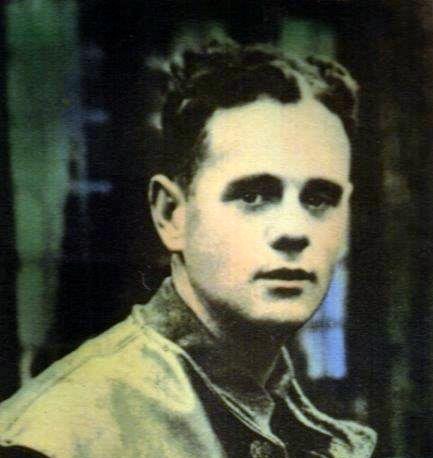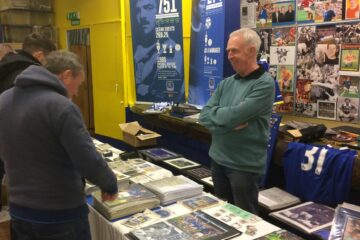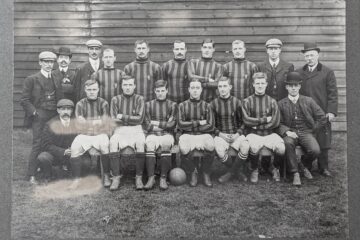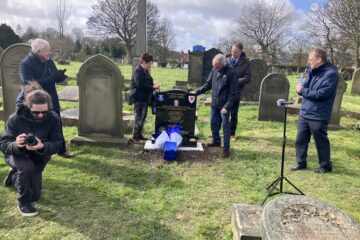By Rob Sawyer
Few footballers’ names are more evocative of bygone times in the Goodison lexicon than that of Cuthbert Tatters. Cuthbert was born in County Durham, on 4 January 1915 and grew up on Sunderland Street in Easington. This was coal mining country and Cuthbert’s father, James, worked at Wheatley Hill Colliery. Cuthbert followed the same path, employed as a pit boy there. On the football field, he played for Shotton Schoolboys, gaining county honours in 1929. He also turned out for Wheatley Hill Juniors. A photo also appears to show him, as a boy, wearing the stripes of Sunderland. Away from football, Cuthbert, an accomplished pianist, provided the musical accompaniment to silent movies in his local cinema.
In 1932, this diminutive inside-forward (5’5” in height), starring for Spennymoor United in the North Eastern League, came to the attention of West Ham United who reportedly offered him a trial. Records confirm that Cuthbert did move south, to the London area, but it appears that he did not make the grade with The Iron. By 1939 he was employed as a senior nurse in St. Ebba’s Hospital (also known as Ewell Mental Hospital), living at 45 Green Lanes in Epsom, with his wife, Olive. Playing district football, a newspaper report from 1939 suggested that Spurs, West Ham and Crystal Palace were interested in signing him…his age erroneously was given as 21, rather than 24 (and error that was repeated in subsequent years – perhaps Cuthbert was happy to shave a few years off, in the hope of attracting football suitors).
War put paid to hopes of securing a professional footballing contract and Cuthbert was called up in 1940 with the RAF, serving as a medical officer (Corporal) attached to construction teams working on the building and repair of military airfields. The work took him to various parts of Britain, plus France, Germany and Australia (based with RAF Transport Command at South Yarra) as the war progressed.

For a period in 1943 and early 1944 the north-easterner was based at Broughton, Lancashire, and crossed paths with Tommy (T.G.) Jones – the classy Everton and Wales centre-half whose RAF service was as a Physical Training Instructor. With a New Year’s Day fixture against Chester at Goodison Park looming, and question marks about the availability of some regular Everton players, Tommy asked Cuthbert along ‘just in case’. Sure enough, he was required and lined up at outside-right in an Everton team comprising: Burnett, Jackson, Greenhalgh, Grant, T.G. Jones (captain), Watson, Tatters (amateur), Wainwright, Boothway (Manchester City), Stevenson, and McIntosh (Preston).

Cuthbert started brightly – his volley from a McIntosh Centre was turned around the post by Scales, the Chester custodian. Later in the first half it was reported: ‘Tatters responded well to a call by Wainwright to cut in, and let go an excellent shot which Scales pushed over the top’.
Of the debutant, Pilot, of the Liverpool Evening Express, wrote: ‘Tatters was certainly making an impression and how he came across field to open up the way for McIntosh, but offside spoiled a fine movement. Tatters trickled Astbury and then Tagg in delightful style’.
The match was a personal triumph for Alex Stevenson who scored four in a 7-0 victory. The Irishman would have added to the tally had he converted two through balls from Cuthbert. However, his through pass to Boothway did result in the sixth goal. Ranger, in the Daily Post summarised the debutant’s contribution:
‘Stevenson, who delighted with his amazing ball control, was the star of the day, and McIntosh and Tatters were excellent on the wings. Tatters is 23-years-old R.A.F amateur who has played occasionally for Spennymoor United and Durham. He was brought to Goodison on Saturday by T.G. Jones in case of emergency, and quickly distinguished himself by his speed, dribbling and canny positioning.’
After this dream Toffees debut, Cuthbert was unavailable for the next fixture but returned to the Everton team for the Merseyside derby on 22 January. The result was a win for the Blues – but it came at considerable personal cost to the guest player. The Blues had already had to shuffle the pack when Norman Greenhalgh was declared unfit shortly before kick-off – having fallen into a car pit at work and injured his leg. Cuthbert took his place at inside-left alongside Tommy Lawton and Jimmy McIntosh. Almost from the first whistle Cuthbert was reported to have ‘dribbled his way through the Liverpool defence but his final pass was smothered out.’ One match reporter wrote: ‘One of the surprises of the game thus far was Tatters, who played like a veteran even to the point of ordering his colleagues what to do.’
On the half-hour mark, immediately after Eddie Wainwright put Everton two goals to the good, Cuthbert left the field nursing an ankle injury. He returned to the fray for the second half, limping badly on the left wing, little more than a passenger. It was subsequently confirmed that Cuthbert had suffered a broken ankle which would be in plaster for 6 weeks. The injury – and the fact that Tatter’s had to play on with it, upset T.G. Jones (who would suffer an ankle injury, himself, against Liverpool, later in the season). In a display of goodwill, not always associated with the Everton Board, the minutes note that he would be ‘offered a professional engagement, should he be prepared to accept same.’ True to the Board’s word, just prior to the commencement of full peacetime domestic football, Everton offered Cuthbert – by now fully recovered from the ankle injury – terms of £5 per week for the 1946/47 season. He duly sought a transfer from his Surrey hospital workplace to the Preston area, under the auspices of the Lancashire Mental Hospitals Board. However, it appears that said board was less than enthusiastic about having Cuthbert split his time between football and nursing. It wrote:
There are certain difficulties which would arise from your transfer to a Lancashire Mental Hospital and accepting a professional engagement with Everton Football Club. I have written fully on the matter to Mr. Theo Kelly, the Everton Club Secretary, from whom you will, no doubt, be hearing.
Yours faithfully,
Deputy Clerk of the Board
The Everton board minutes record that the club gave up on the protracted negotiations, four months later. One can imagine how frustrated Cuthbert must have felt to see his last chance of becoming a fully-fledged professional footballer (at 31 years of age) crushed.

Almost exactly two years later, on 3 September 1948, Cuthbert boarded a ship called Ormonde at Tilbury docks, bound for Melbourne, Australia. The seeds of the move had been sown when Cuthbert was based in Australia during his wartime service. Cuthbert’s son, John, recalls: ‘I do remember when Dad arrived home from the war. His words to Mum were: “We are going to Australia.“ He called us three boys (myself, James and Richard) together and explained to us that Australia was the best country to live in. He showed us a book picturing pineapples growing.’
On the ship’s manifest for the long voyage, Cuthbert’s occupation was listed as a ‘carpenter’s assistant’ – probably a slight bending of the truth in order to satisfy Australian immigration requirements. He was joined by Olive and their three sons (a fourth, Howard, was born in Australia).
John Tatters recalls the family’s first experiences in Australia: ‘When we arrived in Melbourne, we were in the immigration huts for approximately two weeks. Then our Australian sponsor came and, in his beautiful new Chev’, he drove us to Portland, Victoria. Dad worked for this wonderful man, Mr. Harris, who was very kind to us.’
In February 1949 Cuthbert accepted terms of £3 per week to become player coach of Caledonian Soccer Football Club, based in Brisbane, Queensland. The deal almost fell through due to a shortage of accommodation in the Brisbane area but the family did, in time, all settle there. The Telegraph newspaper headline was a pun on the Tatters name: ‘Rags Tatters Arrives’. The name, Rags, stuck from thereon in and very few people in Australian football circles knew that his real name was Cuthbert. He got Caledonian promoted to the state’s top division. Spells followed at Oxley United, Newmarket Postal Institute and Hollandia. At various points, Cuthbert was the Australian Under-23 Coach, an Australian national team selector and Vice President Australian Federation of Coaches




In 1967, he was appointed as State Coach for Queensland – and was in the hot seat when Manchester United played them on their Australian tour. The following year he was appointed as a Master Coach by the Australian Federation of Soccer Coaches. He delivered 10-week soccer training courses to Queensland University Physical Education students. He told the Courier Mail: ‘At first the students were more interested in Rugby, but after a few weeks they began to understand the skills of Soccer and finished the course, last week, thoroughly enjoying it.’ He was not forgotten by some contemporaries from his playing days in England. Stanley Mathews – with whom he had played in the RAF side – visited his house when touring Australia. In April 1969 Cuthbert stepped down from his football positions to focus on his successful contract cleaning business (which remains in the family to this day).
Cuthbert passed away on 4 June 2001 having battled bowel ischemia. He was always grateful to Tommy Jones, who he considered to be a wonderful player, for the opportunity he gave him at Everton – a club he was proud to represent, albeit all too briefly.
Acknowledgments
The Tatters family
Billy Smith (Blue Correspondent website)
Liverpool Echo, Evening Express and Daily Post
Everton: The Official Complete Record (Steve Johnson)
In an unusual footnote to Rob’s fascinating account, we have an intriguing article written by Everton fan Francis Johnson, former Maths teacher at Birkenhead College, who was at Anfield during the war to witness Cuthbert’s second match for Everton on 22 January 1944 against Liverpool. It was sent to Brendan Connolly our former Chairman, by his friend Victor Johnson. Vic is the grandson of the author, and edited the piece sometime during the late 70s/early 80s. He has kindly given us a little more information about how it came to be written;
“My grandfather Francis was born in October 1921 and passed away in January 2005 – so he was 84 when he died. His father started taking him to games at Goodison when he was about five years old, so it would’ve been around 1926 when he went to his first match.
His favourite players were Dixie (of course), TG Jones and Ted Sagar (who was a real favourite of his). He also spoke fondly of Albert Dunlop, Tommy Lawton, Joe Mercer, and was a big fan of Dave Hickson. In later life he adored the ’84/85 team (like a rebirth for him). Sheedy and Trevor Steven were his favourites.
He was a brilliant Evertonian and indoctrinated all of us. (Francis was the father of Paul, Francis and Edward, grandfather of Paul and Victor). He was also a wonderful raconteur and would have the grandkids sitting around his armchair, recounting all the old games and players while puffing on his pipe. That’s how we knew about Tatters. We always felt we were the only kids who knew about Cuthbert Tatters, and because there was next to nothing in the records, we would often tease him that Cuthbert was a figment of his imagination. How wrong we were. I personally asked him to write the story down so that we had a record. And that’s where it comes from. This is the first time it has been seen in public;“
THE SAGA OF CUTHBERT TATTERS
War-time football matches were a constant surprise. It was often not known until a few minutes before the kick-off just who was playing. The team sheet for any given match, sold at a nominal price, often bore little resemblance to the actual twenty-two players, linesmen and referee who took part. The pre-war big clubs were an obvious attraction for star players who found themselves posted to a unit close to a big club. In fact, war-time games were only possible because of the use of guest players. Some of the smaller clubs benefited too. For example, Aldershot, due to their association with the army, often fielded a side containing a majority of internationals. Britton, Cullis and Mercer were the half-back line for a short time. What more could a third division team hope for? There was of course a flipside to that coin; a number of little known players found themselves in the company of well-known stars. The combinations were endless. For instance, Everton once fielded a forward line of Anderson, Rosenthal (both of Tranmere Rovers), Lawton, Stevenson and Fowler who was a pre-war reserve team player. The great T.G.Jones was the centre-half on that occasion and he was flanked by an Everton reserve team wing-half, Fairfowl, and a lad called Curwen from Southport. It was a strange looking Everton team that took on a Blackpool side containing Matthews, Dixon, Dodds and Burbanks, all stationed at Squires Gate, Blackpool, all in the R.A.F and all internationals. Incidentally, Everton won 4-3.
I remember one Derby match at Anfield sometime in 1944. The Anfield ground at that time had a public address system which was roughly 75% efficient; meaning not that it would work correctly 3 times in 4, but that you merely heard 3 words in 4. Perhaps because it was a Derby match it seemed to be on its best behaviour, for in the clearest of tones it informed us that at inside-left for Everton would be a certain Cuthbert Tatters. A moment of silence followed and then the Evertonians gave tongue.
“Cuthbert…who?” was the biggest response among those who enquired in the civilised patois of the Everton paddock at the time.
“Cuthbert Tatters…never ‘eard of ‘im”, came in a close second from those still working within the confines of civilised enquiry, followed by “Tatters…Tatters, where on earth did they get ‘im from?”
There were many variations in what the old-time novelists used to call ‘colourful language’. The consternation and dismay among the Everton supporters was pitiful to see.
The Liverpudlians in my vicinity smirked among themselves. It was clearly a classic case of the vicissitudes of war-time football. Everton couldn’t raise a team. War-time working and Service duties had compelled them to include the local paper boy, or so it seemed to that rara avis of Red supporters, i.e. the thinking man. Incidentally, for those who failed to achieve those higher levels of education prerequisite for gaining admission to the Gwladys Street end, rara avis is Latin for ‘rare bird’.
The Everton supporters near me and I suppose the Evertonians everywhere in the ground were unanimous – firstly, in that no footballer could possibly have the name ‘Cuthbert’, and secondly, with a neat reversal of opinion, that no player called ‘Cuthbert’ could play for Everton. The surname ‘Tatters’ was considered to be one of life’s little problems to be accepted philosophically like food rationing, National Service call-up or any other of the innumerable restrictive aspects of war-time reality. Although, as they were quick to point out ‘ they had never met a fellow called Tatters at any time’.
However, their disbelief that anybody called Cuthbert Tatters could wear a blue shirt went out of the window when the teams appeared. Everybody looked for number 10. He was there alright – a complete stranger. Round and chubby with fair hair and a schoolboy’s looks, he was, perhaps, eighteen. Something like a young version of Jimmy Gabriel and about the same size, if not so strongly built.
His appearance silenced some of the critics. He certainly looked as if he might be able to play. The manner in which he took part in the warm-up seemed to show that at least he wasn’t the local paper boy. But, was he good enough to play for Everton? Those who harboured such doubts found out, and quickly to boot. Within seconds of the kick-off he had the ball under control, side-stepping one opponent, slipping past another and sending a perfect pass out to the Everton right-wing. Within minutes he was playing as if he had always played for Everton. The Liverpool team that day was composed of seasoned professionals like Jack Balmer, Don Welsh, Willie Fagan and ‘Nivvy’, who was playing right-half and supposedly marking Cuthbert Tatters. In the first fifteen minutes Tatters took them all on, particularly ‘Nivvy’ and made them look like novices. The display of ball control by young Tatters was simply breath-taking. In all my years of watching the best, I have never seen anyone better at manipulating a football, and that includes Matthews, Finney, Fielding, Stevenson and all the other stars who are known for their skilful dribbling. Cuthbert Tatters, an eighteen year old amateur from the R.A.F was recommended to Everton by T.G.Jones who served on the same R.A.F station. He was a Geordie and T.G had certainly found a winner.
At the time it seemed to be almost too good to be true. Alas, for all Evertonians, it was. For fifteen minutes young Cuthbert tore the Liverpool defence to shreds, one could say tatters! In that time he jinked, dodged and danced his way around and past the Red shirts and rendered them as innocuous as if they were not on the same field. He evaded lunging tackles with an amazing display of footwork, nut-megged them as they came, beat them once, twice and even again, if a Reds player was sufficiently enthusiastic as to try a third time. Everton scored in that period when Tatters, having swerved and slipped around at least three bemused defenders, supplied Lawton with a perfect pass from which the centre-forward couldn’t fail to score. In no time at all he stamped his presence on the match in a manner which I have never seen equalled. For skilful ball control he was simply a revelation. The crowd took to him in seconds and every time he played the ball roared their appreciation. And he certainly gave them something to roar about.
There will be some of those present still alive who will certainly remember Cuthbert Tatters. You might meet one some day in your local. Try saying Cuthbert Tatters to anyone over sixty and, should you be lucky, I guarantee that you will meet a man whose memory for a few seconds will be transported into paroxysms of delight. As a further guarantee he will certainly buy you another while he tells you of the Saga of Cuthbert Tatters. If saga means a long story you could be occupied for some time!
Of course, it couldn’t last. After fifteen minutes Tatters was taken out by Nivvy, about the only time that Nivvy got anywhere near him. He left the field on a stretcher. We never saw him again.
Years after T.G.Jones gave a press interview and mentioned his protégé. Jones said that Tatters had told him that he would never play with professionals again, preferring to remain in the amateur ranks. The injury sustained at Anfield put him out of action for many weeks. As T.G lost track of young Cuthbert after the war, it can only be presumed that Tatters kept his word and remained an amateur, if indeed he ever played again. Had he remained at Everton I am sure that established stars like Fielding and Stevenson would have been pushed hard in keeping their places in the team.
In fifty years of following football Tatters will remain for me the most natural of naturals.
Cuthbert Tatters, a unique footballer with a unique name. I will always remember the day that an eighteen year old amateur footballer donned the royal blue jersey and showed the professionals just how it should be done.
Francis Johnson
Nil Satis Nisi Optimum
With grateful thanks to Victor Johnson and his family for sharing Francis’ article





A few generations later another tatters lives.